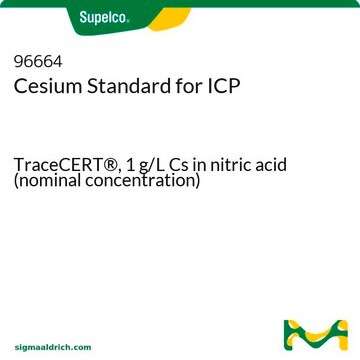239240
Cesium
ingot, ≥99.95% trace metals basis
Synonym(s):
Caesium
About This Item
Recommended Products
vapor pressure
1 mmHg ( 279 °C)
Assay
≥99.95% trace metals basis
form
ingot
reaction suitability
reagent type: reductant
packaging
pkg of Packaged in: Breakseal Ampule
resistivity
19 μΩ-cm, 0°C
bp
705 °C (lit.)
mp
28.5 °C (lit.)
density
1.873 g/mL at 25 °C (lit.)
SMILES string
[Cs]
InChI
1S/Cs
InChI key
TVFDJXOCXUVLDH-UHFFFAOYSA-N
Looking for similar products? Visit Product Comparison Guide
General description
Application
- Cesium-containing triple cation perovskite solar cells: improved stability, reproducibility and high efficiency: Demonstrates how adding cesium to perovskite solar cells improves their stability and efficiency, making a significant advancement in solar technology (M Saliba et al., 2016).
- Exotic stable cesium polynitrides at high pressure: Explores the formation of new cesium polynitrides under high pressure, indicating potential applications in high-energy-density materials (F Peng et al., 2015).
Signal Word
Danger
Hazard Statements
Precautionary Statements
Hazard Classifications
Skin Corr. 1B - Water-react 1
Supplementary Hazards
Storage Class Code
4.3 - Hazardous materials which set free flammable gases upon contact with water
WGK
WGK 3
Flash Point(F)
Not applicable
Flash Point(C)
Not applicable
Personal Protective Equipment
Certificates of Analysis (COA)
Search for Certificates of Analysis (COA) by entering the products Lot/Batch Number. Lot and Batch Numbers can be found on a product’s label following the words ‘Lot’ or ‘Batch’.
Already Own This Product?
Find documentation for the products that you have recently purchased in the Document Library.
Customers Also Viewed
Our team of scientists has experience in all areas of research including Life Science, Material Science, Chemical Synthesis, Chromatography, Analytical and many others.
Contact Technical Service












